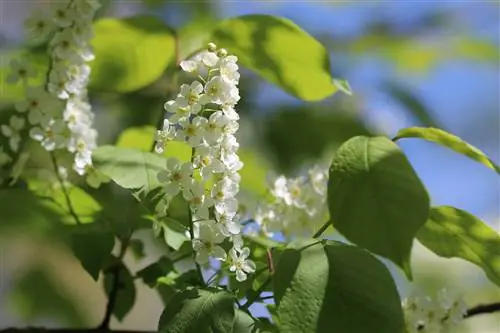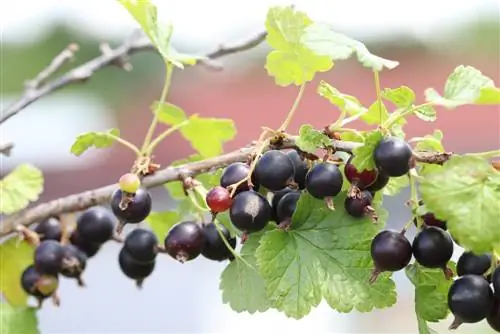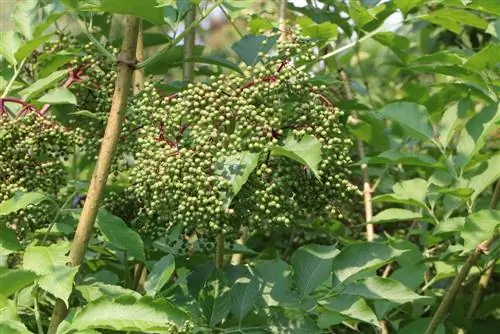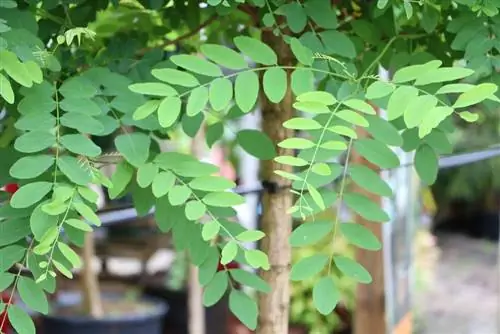- Author admin [email protected].
- Public 2023-12-17 03:39.
- Last modified 2025-01-24 12:45.
The black-eyed Susan, the climbing plant with bright flowers, has taken the hearts of hobby gardeners by storm. We'll show you what to pay attention to when caring for it.
Profile
- Origin: Africa
- not hardy
- left-winding growth (counterclockwise)
- Flower colors: orange, white, red, yellow and pastel colors
- Flowers: funnel-shaped, double or unfilled
- Growth height: 2 to 3 meters
- pH value: slightly alkaline to slightly acidic
Features
The black-eyed Susan (Thunbergia alata) belongs to the acanthus family (Acanthaceae). More than 100 varieties are known worldwide. The climbing plant with bright flowers and heart-shaped leaves is mostly cultivated as an annual ornamental plant in Central Europe. In its warm African home it thrives perennially. It is suitable as a container plant and also feels comfortable outdoors. If you keep the easy-care plant protected over the winter, you can enjoy its blooms for several years.
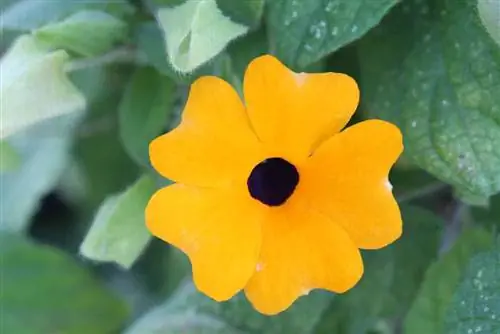
The climbing plant is often used to green facades, fences and pergolas. It is ideal as a privacy screen. Thunbergia alata grows hanging as a hanging basket plant or in balcony boxes. Some varieties grow up to 20 centimeters per month. Trellises made of rods, grids or ropes give the plant stability and enable growth to be influenced.
Tip:
The Black-Eyed Susan is a good choice for gardens where children run around. If you accidentally put a Thunbergia alata flower in your mouth while playing, there is no danger. Like all other parts of the plant, the flowers are non-toxic to humans and pets.
Flowering time
The blooming period of the black-eyed Susan extends from June to October. Anyone who only knows the common Thunbergia alata Aurantiaca with yellow-orange flowers with a black calyx will be surprised by the new varieties.
Other enchanting varieties are available in specialist shops, such as:
- Alba with white petals
- Lutea with light yellow petals
- African Sunset with burgundy petals
- Pink Surprise with pink petals
Tip:
Remove spent flowers regularly to prevent seed formation and to encourage new flower formation.
Site conditions
For the African climbing plant to feel comfortable in our latitudes, its location must above all be warm and sunny, but also protected from wind and rain. The black-eyed Susan needs a large container and a nutrient-rich, loose, calcareous substrate. High-quality geranium soil is suitable. Note that the plant can reach a height of up to three meters. It requires ropes or trellises as climbing aids.
By the way:
The black-eyed Susan also cuts a fine figure as a ground cover. You can easily use it to green slopes on your property. Before you know it, a glowing sea of flowers will emerge.
Propagation by seeds
The Thunbergia alata is usually offered as a young plant by balcony flower growers. If you have a little skill and a lot of patience, you can sow the climbing plant yourself. The early sowing date in January is crucial. The plant needs four months to flower.
Instructions
- Fill bowls with potting soil
- Lay out seeds three centimeters apart
- cover with a layer of soil about one centimeter thick (dark germ)
- Press earth
- Cover seed trays with a lid or foil
- Germination temperature 20 to 22 degrees Celsius
- Germination time about two to three weeks
- After germination, place the seed trays at 18 degrees Celsius
- Prick out plants after the first leaves develop
- plant in small pots with potting soil in threes
- Use trellises
- fertilize carefully with liquid flower fertilizer from April
- Keep the soil in the plant pots moist
Note:
Each flower produces four seeds. If you collect these carefully, you will get enough seeds for the next year. Lay the seed out to dry. Fill the dried seeds into airtight containers.
Propagation by cuttings
Cuttings can be easily obtained for propagation from strong specimens of Thunbergia alata.
Instructions
- Separate well-developed shoots with a sharp knife at the end of July/beginning of August
- leave the upper leaves, remove the lower ones completely
- fill a suitable container with potting soil
- Planting cuttings
- pouring
- place in a warm place, keep moist
- fertilize carefully from the beginning of March
Tip:
For optimal bushy growth of the young plants, trimming, the shortening of the shoot tips, is necessary. Two new shoots emerge in the places where a shoot tip was removed. For vigorous plants, repeat this process again after four weeks. To trim, use sharp, cleaned scissors.
Planting out
Before the young black-eyed Susan plants obtained from seeds or cuttings or purchased can be planted outdoors, they should slowly get used to the outside temperatures. Under no circumstances are they allowed into the garden before the Ice Saints. Bring the potted plants back into the house at night when temperatures are low.
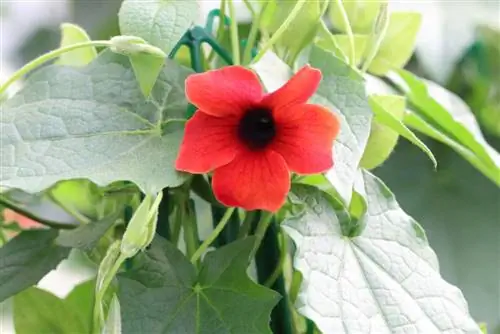
The planting pit should be at least 1.5 times as large as the root ball. Fill the bottom with coarse gravel or broken clay. You can plant the climbing plants in groups with a minimum distance of 50 centimeters.
Fertilize
From around April onwards, the nutrients in the growing pot are no longer sufficient for the small plants. They must be fertilized very carefully. We recommend commercial flower fertilizer in a minimal dose. After planting in the pot, a slow-release fertilizer can be used. Due to the long flowering period, the plant requires weekly flower fertilizer from around June.
Pouring
Young plants need substrate with low but consistent moisture. Drying out and excessive watering impairs growth. When the black-eyed Susan is in bloom, it needs plenty of water.
Attention:
The plant does not tolerate waterlogging. After watering, wait until the water runs out of the drain hole and pour off the water collected in the saucer.
Pests and diseases
The Thunbergia alata generally grows very robustly. Brown leaf tips are an indication that the humidity is too low. Plants that are kept in the house over the winter must be additionally humidified when the heating air is dry.
Spider mites are often observed on the plant. Fine webs and white spots on the leaves are sure signs. Spider mites love dryness and warmth. A vigorous shower will help eliminate the pests. Spraying the leaves with rapeseed oil kills the mites.
Plants of the genus Thunbergia alata are often attacked by theWhitefly (Trialeurodes vaporariorum). The small flies stay on the undersides of the leaves and suck the plant sap. Sticky, yellow-spotted leaves are a sure sign of an infestation. Yellow stickers help against adult animals. Parasitic wasps are also suitable for combating pests.
Cutting
The growth of the decorative plant can be stimulated by pruning it in spring. We recommend shortening the shoots to two thirds of their length.
Wintering
Many flower lovers shy away from the effort, but the black-eyed Susan can be easily overwintered. Potted plants survive the winter undamaged in a frost-free basement. Overwintering planted specimens is difficult. They form extensive roots in the first year. When digging, injuries often occur and the plant dies. An alternative to overwintering adult plants is to take cuttings. These come over the winter in small planters without much effort.


